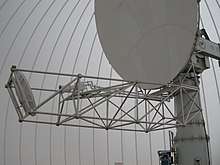CSU-CHILL
Colorado State University - CHicago ILLinois radar, colloquially CSU-CHILL, is a semi-mobile, dual-frequency weather surveillance radar developed in 1970 by the University of Chicago[1] and the Illinois State Water Survey,[2] which has since been moved to Colorado on behalf of Colorado State University.[3] The radar was operated through a cooperative agreement with the National Science Foundation.[4]
 | |
| Country of origin | United States |
|---|---|
| No. built | 1 |
| Type | Weather radar |
| Frequency | 2735 MHz (S-band) 9415 MHz (X-band) |
| Beamwidth | 1.1° |
| RPM | 0-33 deg s−1 |
| Diameter | 8.5 m |
| Elevation | 0°-90° |
| Power | 800 kW - 25 kW (S and X-band) |
Description
CSU-CHILL is used to study atmospheric principles and precipitation on a small scale with the use of two frequencies. It has a transmitter consisting of both S and X-bands, both using a klystron. Each transmitter can individually transmit its respective frequency through its own feed horn onto the 9m offset parabolic antenna. This configuration also aids in the ability to gather samples from various polarizations. From these, the type of precipitation can be easily discerned.[5]
CSU-CHILL is protected by a pneumatic dome, and is close to its control buildings.[6] It is often positioned near Greeley, Colorado, but is semi-mobile, so that it is movable in separate pieces, and can be quickly assembled or disassembled to participate in a field study.[7]
References
- Huanyao Dai, Xuesong Wang, Hong Xie, Shunping Xiao, Jia Luo (20 June 2018). Spatial Polarization Characteristics of Radar Antenna: Analysis, Measurement and Anti-jamming Application. Springer. pp. 17–. ISBN 978-981-10-8794-3.CS1 maint: multiple names: authors list (link)
- National Science Foundation (U.S.) (1966). Weather Modification: Annual Report. National Science Foundation. pp. 4–.
- Wolff, Dipl.-Ing. (FH) Christian. "Radar Basics - CSU CHILL". www.radartutorial.eu.
- V. N. Bringi; V. Chandrasekar (30 August 2001). Polarimetric Doppler Weather Radar: Principles and Applications. Cambridge University Press. pp. 14–. ISBN 978-1-139-42946-7.
- "Facilities - CHILL". www.chill.colostate.edu.
- "American Meteorological Society". Journal of Atmospheric and Oceanic Technology. Journals.ametsoc.org. 17: 1596. 2000. doi:10.1175/1520-0426(2000)017<1596:ADOTCC>2.0.CO;2. hdl:10217/68087. ISSN 1520-0426.
- "Hardware description - CHILL". www.chill.colostate.edu.